An Engine Exhaust Particle Sizer was used on a mobile platform to measure ultrafine particle (5.6–560 nm) concentration profiles in streets and tunnels. Particle size distribution data along the lengths of the tunnels showed that number concentration profiles of < 30 nm particles were highly nonlinear. Conventional point measurement studies inside tunnels to determine, for instance, emission factors of ultrafine particles in this range are therefore location dependent and may not be representative. The particle concentration profiles obtained in this experiment allowed the study of the transformation of 10 nm particles to 50 nm particles. Outside of the tunnels and on heavily traveled highways, particles exhibited a dominant mode at 10 nm and a minor mode at 50 nm. Inside the tunnels, 10 nm particles gradually decreased after an abrupt increase, while 50 nm particles increased from entrance to exit. The 10 nm particles decreased at 2–4 times the rate of increase of the 50 nm particles, therefore, condensational growth of the 10 nm particles alone cannot explain the decrease. The estimated hetero-coagulation rate between 10 nm particles and particles > 30 nm inside the tunnel was substantially higher than that outside due to the increase in the concentration of particles > 30 nm. The hetero-coagulation process is proposed to play a key role in the transformation of particle modes in the tunnel. This study provides new insight on the transformation of ultrafine particle modes in vehicular plumes.
1. INTRODUCTION
Ultrafine particles (< 100 nm) constitute less than 10% of the total particle mass in the atmosphere (CitationPakkanen et al. 2001; CitationLaakso et al. 2003; CitationMorawska et al. 2003), however, in number concentration, they overwhelm particles > 100 nm. There are several sources of ultrafine atmospheric particles, e.g., primary emission from vehicles, aircraft, etc. (CitationKittelson et al. 2004), binary nucleation of H2SO4 and H2O, and ternary nucleation of H2SO4, H2O, and NH3 in the atmosphere (Sturm et al. 2003; CitationKulmala et al. 2004). The formation rate of ultrafine particles by nucleation in the atmosphere is 2–3 orders of magnitude smaller than that in plumes emitted from road vehicles. Because of the huge number concentration of the ultrafine particles, they are thought to be responsible for the increase in risk in respiratory and cardiovasculary diseases (CitationPeters et al. 1997). Several mechanisms have been proposed to link ultrafine particles to observed health effects (CitationChurg et al. 1999; CitationBrown et al. 2000). It is, therefore, important to study the abundance, size distribution and transformation of these particles to better understand their potential impact on health. This study focuses on ultrafine particles emitted from road vehicles and in particular, in tunnels where they are found in abundance.
Ultrafine particle size distributions have been widely reported in the atmosphere, in tunnels and in laboratory experiments (CitationBukowiecki et al. 2002; CitationKim et al. 2002; CitationMolnár et al. 2002; CitationZhu et al. 2002; CitationKetzel et al. 2003; CitationLehmann et al. 2003; CitationKittelson et al. 2004). Ultrafine particle size distributions are complicated and vary according to the environment. CitationMaricq et al. (2001) reported that changes in background aerosol caused noticeable inconsistencies in laboratory measurements of particles emitted from vehicles. The background particles can, therefore, exert significant influence on the transformation of ultrafine particles emitted from vehicles and warrants investigation. However, there has not been any experimental study on the influence of background particles on the transformation of particles in on-road vehicular plumes.
A Model 3090 Engine Particle SizerTM spectrometer (EEPS) (TSI, Inc.) onboard the Mobile Real-time Air Monitoring Platform (MAP) was used to obtain temporal and spatial size distributions of ultrafine particles as the platform traveled. Special emphasis was given to tunnel data. Longitudinal MAP particle concentration profiles obtained in tunnels represent fresh aerosols at the entrance section and more aged ones at the exit section. Conventionally, measurements inside tunnels are made at selected spots providing only snapshots of the variation of air pollutants in the tunnel.
Tunnels are ideal for studying the transformation of ultrafine particles emitted from road vehicles because the space is confined and the conditions are “controlled.” The main source of particles is vehicular (fresh and aged) with, perhaps, a minor contribution from resuspended road dust. There is little interference from other sources. The air movement in tunnels is complicated and depends on a number of factors such as traffic flow, ventilation, and the piston-effect caused by the moving vehicles (CitationChang and Rudy 1990). In Hong Kong, vehicle speed inside tunnels (70 km hr− 1) is strictly controlled and overtaking is prohibited. All these set up an ideal environment for studying the dynamics of air pollution due to vehicles. In this study, we focused on the transformation mechanism of ultrafine particle modes, especially the interaction between background particles with freshly formed vehicular particles.
2. EXPERIMENTAL
In addition to the EEPS, the following instruments were also onboard MAP: an Electrical Low Pressure Impactor (ELPI) (Dekati, Ltd.); stand-alone gas analyzers for SO2, NOx, CO, and O3 (API, Inc.); an aethalometer (Magee Scientific) to measure black carbon; an automatic weather station; a composite global positioning system (GPS), digital compass, and speedometer navigation system. The EEPS was used to measure particle sizes from 5.6 nm to 560 nm at a rate of 32 channels with a measurement time of 3.2 seconds. MAP is designed to make measurements at 50–70 km hr− 1.
Nine days of ultrafine particle size distribution data were measured using EEPS in urban and rural areas, and tunnels in Hong Kong on 23 and 27–28 September and 7–8, 11–14 October 2004. The measurements usually started at 10:00 and ended at 16:00. Approximately 60 sets of data in different tunnels were obtained and the speed of MAP inside tunnels was 55 ± 5 km hr− 1. The aerosols measured in tunnels by MAP can be classified into three general types. In the first two types, the aerosols were similar to gasoline or diesel engine exhausts reported in the literature (CitationBukowiecki et al. 2002; CitationLehmann et al. 2003; CitationKittelson et al. 2004). These occurred when either a gasoline or a diesel vehicle was a short distance (5–30 m) ahead of MAP. In these cases, MAP measured highly localized emissions from the vehicle in the front. The transformation of freshly emitted engine particles has been examined in a number of studies (CitationBukowiecki et al. 2002; CitationMolnár et al. 2002; CitationZhu et al. 2002; CitationKetzel et al. 2003; CitationLehmann et al. 2003; CitationKittelson et al. 2004). The third type of particle size distribution was measured when there was > 30 m distance between MAP and the vehicles in front. In this situation, dispersed yet highly concentrated vehicular emissions were sampled, providing an opportunity to study the transformation of nucleation mode particles to background particles. The > 30 m buffer between MAP and the vehicle in front was determined from the massive data collected in 2002–2003.
3. RESULTS AND DISCUSSION
The data obtained from sampling in two tunnels with different lengths are examined in this paper. The Tate Cairn's Tunnel (TCT) is ∼ 4 km in length while the Lion Rock Tunnel (LRT) is only 1.4 km long. The roadway grade is negligible in both tunnels. The daily average traffic volumes in TCT and LRT were 62,630 and 88,770 vehicles day− 1, respectively, in September 2004. The ratio of passenger vehicles to diesel trucks (80% to 20%) in the two tunnels was similar for this period. Longitudinal ventilation system was used in TCT with a total fresh air supply of 6,912,000 m3 hr− 1 and full transverse ventilation system was used in LRT with a total fresh air supply of 1,359,600 m3 hr− 1 and the total exhaust air flux of 1,152,000 m3 hr− 1. The lengths of the tunnels, ventilation, and traffic flow, have significant impact on the accumulation of air pollutants inside (CitationChang and Rudy 1990), especially for species with long lifetimes. The former tunnel was measured on 23 September 2004 and the latter on 27 September 2004.
EEPS measurements were made outside the tunnels to determine the background aerosol. The particle number mode and number median diameter (NMD) were determined by fitting the EEPS data with log-normal distribution functions using the DISTFIT software (TSI, Inc.). Ultrafine aerosol size distributions measured in background, light and heavy traffic areas on 23 September 2004 are shown in and summarized in . The aerosol representative of rural area particles consisted of a single mode at 50 nm (). This Aitken mode aerosol was formed by a combination of condensation and coagulation growth of nucleation mode particles (CitationSeinfeld and Pandis 1998; CitationGidhagen et al.s 2003). CitationWoo et al. (2001), CitationBukowiecki et al. (2002), and CitationKetzel et al. (2003) have previously observed this particle number mode in the atmosphere. also shows 30 nm particle mode that was observed on a light traffic country road that is used by occasional heavy-duty diesel vehicles to serve a construction site, therefore, these particles were probably associated with these heavy-duty diesel vehicles. A bi-modal size distribution with a dominant mode at 10 ± 1 nm and a minor mode at 50 ± 5 nm was frequently measured in high concentration gasoline vehicle plumes in urban streets (). This bi-modal size distribution was similar to other roadside and laboratory studies (CitationBukowiecki et al. 2002; CitationMolnár et al. 2002; CitationZhu et al. 2002; CitationKetzel et al. 2003). CitationKim et al. (2002) and CitationZhang and Wexler (2002) found that a combination of nucleation and coagulation could form 10 nm particle mode. The 10 nm mode was ascribed to the evolution of nucleated particles (CitationKim et al. 2002; CitationZhang and Wexler 2002; CitationGidhagen et al. 2003). CitationZhang and Wexler (2002) estimated that freshly nucleated particles grew to 10 nm in about 400 s in the atmosphere, however, it took < 10 s for nucleated particles to grow to 10 nm size in highly concentrated plumes (Jacobson and Seinfeld 2002). The 10 nm mode could be formed in tailpipes and/or in dispersed vehicular plumes.
Figure 1 Size distribution of ultrafine particles in rural, light and heavy traffic areas on 23 September 2004.
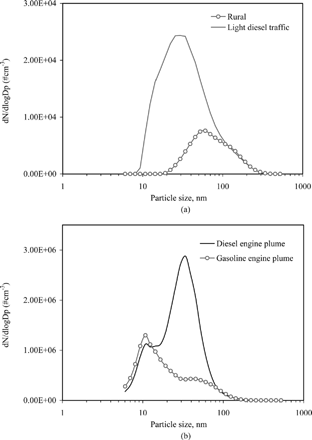
Table 1 Mode patterns of ultrafine particles in background, light and heavy traffic areas (23 September 2004)
In high concentration heavy-duty diesel vehicle plumes at traffic exchanges, a bi-modal size distribution with a dominant mode at 30 ± 4 nm and a minor mode at 10 ± 1 nm was observed (). CitationKim et al. (2002) previously detected such a bi-modal distribution from diesel engine emissions in a wind tunnel, but CitationLehmann et al. (2003) only observed the 30 nm mode in emissions of heavy-duty engines in test cycles. Overall, the particle size distributions measured in this study were similar to those previously reported in roadside or in laboratory measurements.
shows the particle number concentration, black carbon, and gas concentration profiles in TCT. TCT is oriented roughly in the north-south direction. MAP entered the tunnel at 10:24:40 and left at 10:28:34. The measurement lasted for 234 s and for the sake of clarity, the entrance of the tunnel is at distance = 0 m. For particles < 20 nm in mobility diameter, the concentration rapidly reached the maximum in the first 500 m before decreasing throughout the rest of the tunnel. The concentration of these particles < 20 nm varied over one order of magnitude in the tunnel. The drastic dip in concentration before the entrance of the tunnel was probably caused by a combination of vehicles lining up to enter the tunnel (therefore MAP would not be able to keep the > 30 m distance desired), entrance effect and forced ventilation inside the tunnel.
Figure 2 Concentration profiles of ultrafine particles, black carbon, and gases in Tate Cairn's Tunnel from10:25 to 10:29 on 23 September 2004. (Black carbon in μ g m− 3; gases in ppb; number concentration in cm− 3.)
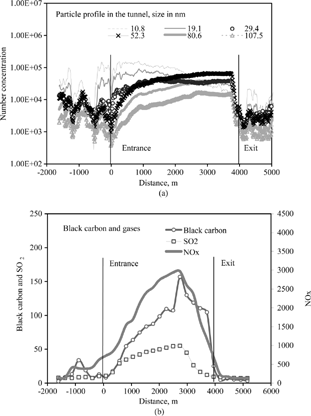
For the particles > 30 nm, the concentration increased almost linearly for the first 2700 m and reached a constant value for the remaining distance. There was a ∼ 30-fold increase in number concentration from entrance to exit. At the exit of the tunnel, the concentrations dropped drastically due to the dilution effect caused by the outside air mass. It is interesting to note that the concentration of ∼ 30 nm particles linearly increased and reached a constant value in the first 1500 m. It took the particles > 30 nm longer to achieve this. Diesel emissions have a dominant mode at 30 nm as reported by CitationKim et al. (2002) and the same mode was detected in high concentration diesel plumes in urban streets in this study as shown in . Thus, it is apparent that the 30 nm particles were associated with heavy-duty diesel vehicles.
Particle size distributions, along the entire length of the tunnel, were analyzed to study the transformation of ultrafine particles in a high concentration and “controlled” environment. As shown in , bi-modal size distributions were observed both inside and outside of the tunnel at the two ends. Before MAP entered the tunnel, the dominant mode was at 10 nm together with a minor mode at 50 nm. The dominant mode remained at 10 nm once inside the tunnel and the particle number concentration rapidly increased. Deeper into the tunnel, the 10 nm mode particles gradually decreased while simultaneously the 50 nm mode particles increased. At the exit of the tunnel, 50 nm dominated and 10 nm became minor. After MAP left the tunnel, the 10 nm mode dominated again but the concentration decreased by approximately two orders of magnitude.
Figure 3 Transformation of ultrafine particle modes in Tate Cairn's Tunnel from 10:25 to 10:29 on 23 September 2004 (dN/dlogDp in cm− 3).

For the first three quarters of the tunnel (0–2700 m), air pollutants such as black carbon, SO2 and NOx rapidly accumulated and increased with the length of the tunnel (). Presumably, other gaseous precursors of nucleated particles behaved in a similar fashion. The increase of gaseous precursors would promote nucleation to form particles followed by coagulation to form the 10 nm particle mode. However, the presently observed 10 nm particle increase did not quite follow this. They increased rapidly for the first 800 m in the tunnel and a marked decrease was observed from 800 m to 2700 m where there was an increase in the particles > 30 nm. For the entire tunnel, the decrease of the 10 nm particles was approximately four times of the increase of the 50 nm particles as shown in , therefore considering only the condensation growth of the 10 nm particles cannot explain the large decrease in the 10 nm particles.
Two processes could be responsible for the decrease of the 10 nm mode particles. One is the decrease in the precursor gases that form these particles, the other is the increase in the depletion rate of the 10 nm particles lost to coagulation and/or the decrease in the formation of new 10 nm particles. Obviously, the first process was not likely to be the case, this leaves the competition between the depletion and formation processes to be the reason. shows much higher particles > 30 nm inside the tunnel than outside. Rapid mode transformation between 10 nm and 50 nm particles was observed inside the tunnel but not outside. Coagulation of particles between 10 nm and > 30 nm depletes the 10 nm particles, while coagulation of particles between < 10 nm and > 30 nm decreases the formation rate of the 10 nm particles. A net loss of 10 nm particles resulted. To substantiate this, the heterocoagulation rates of 6 nm and > 30 nm particles, 10 nm and 10–30 nm particles, and 10 nm and > 30 nm particles, and the self-coagulation rate of 6 and 10 nm particles in Tate Cairn's Tunnel were calculated using the following equation.
The coagulation rate of “a” particles on “b” particles (Jab) is estimated by the equation below:
In the calculation of coagulation rates, concentration profiles of the particles involved are needed. The measured concentration profiles can be used. Underestimation is to be expected because these particles already are the product of coagulation processes. Another method is to assume that particle behavior for the 10 nm and > 30 nm particles are similar in the absence of coagulation. It has been reported that one major difference between 10 nm and > 30 nm particles is that coagulation growth is not important for the > 30 nm particles (CitationKim et al. 2002, CitationZhang and Wexler 2002). In the first 500 m of the tunnel where > 30 nm particle concentration was low, fairly good correlation between 10 nm and > 30 nm particles was found (R2 is 0.64 for 10 nm and 50 nm particles), suggesting that the 10 nm and > 30 nm particles behaved similarly in this section. The > 30 nm particles inside the tunnel increased to a maximum value and held constant until the exit section (). It then can be assumed that the 10 nm particles display a similar concentration profile when coagulation processes are absent. In this assumption, the 10 nm particle concentration artificially follows the trend of the 30 nm particles, i.e., it increases to a maximum value from the entrance of the tunnel and steadies out until the exit section. For other size particles, the measured concentrations are still used.
shows the coagulation rates calculated using measured concentrations. shows the heterocoagulation rate of 6 nm particles with particles > 30 nm and the self-coagulation rate of 6 nm particles inside and outside the tunnel. The heterocoagulation rate (65 cm− 3 s− 1, on average) inside the tunnel was several times to 1–2 orders of magnitude higher than the rate outside the tunnel. Since particles < 10 nm are possible precursors of the 10 nm particles, the increase in the heterocoagulation rate inside the tunnel would lead to a decrease in the formation rate of the 10 nm particles. shows the heterocoagulation rates of 10 nm particles with particles > 30 nm, 10 nm particles with 10–30 nm particles, and the self-coagulation rate of 10 nm particles inside and outside the tunnel. Just as the 6 nm particles, the heterocoagulation rate of 10 nm particles with particles > 30 nm (206 cm− 3 s− 1, on average) increased substantially inside the tunnel. Although the heterocoagulation rate of 10 nm particles with particles between 10–30 nm (77 cm− 3 s− 1, on average) also increased inside the tunnel, the rate was only about one-third (on average) that of 10 nm particles with particles > 30 nm. Moreover, inside the tunnel the heterocoagulation rates of 10 nm particles with 10–30 nm particles and particles > 30 nm were several times larger than the self-coagulation rate of 10 nm particles (16 cm− 3 s− 1, on average), indicating that the heterocoagulation is an important sink of the 10 nm particles.
Figure 4 Heterocoagulation and self-coagulation rates in Tate Cairn's Tunnel from 10:25 to 10:29 on 23 September 2004. (a) Rate of 6 nm particles with > 30 nm particles and 6 nm particle self-coagulation rate; (b) Rate 1 of 10 nm particles with > 30 nm particles, Rate 2 of 10 nm particles with particles between 10–30 nm, and 10 nm self-coagulation rate.
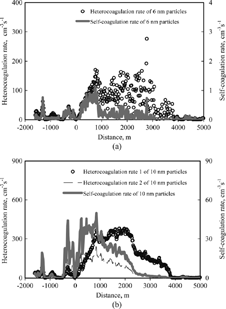
A comparison between the coagulation rates calculated using measured and assumed particle concentration profiles can be found in . It can be seen that the assumed heterocoagulation rate increased with the length inside the tunnel, and was more than one order of magnitude higher than the self-coagulation rate. This also suggests that heterocoagulation is an important sink of 10 nm particles inside the tunnel due to the increase in the concentrations of particles > 30 nm. At the entrance section of the tunnel, the concentration of particles > 30 nm was too low to decrease the concentration of 10 nm particles through coagulation, however, as the concentration of particles > 30 nm increased deeper into the tunnel, they became more important. This led to a switch in the dominant and minor particle modes in the exit section.
Figure 5 Comparison of heterocoagulation and self-coagulation rates in Tate Cairn's Tunnel from 10:25 to 10:29 on 23 September 2004 using the measured and assumed 10 nm particle concentrations (heterocoagulation rate is the rate of 10 nm particles with > 30 nm particles, rate 1 is estimated using the measured concentrations and rate 2 is estimated using the assumed concentrations).
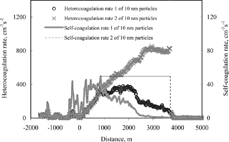
CitationJacobson and Seinfeld (2004) theoretically simulated the evolution of nanometer particles near point and line emission sources and found that heterocoagulation between freshly formed particles and larger background particles increased in relative importance with increasing background particles. This supports our analysis of the coagulation between 10 nm and particles > 30 nm in tunnel.
In is a correlation of the depletion of the 10 nm particles and the growth of the 50 nm particles in volume concentration. The volume concentration changes are calculated with reference to the volume concentration of the respective particle size at 850 m of the tunnel. The good correlation (R2 = 0.85) clearly demonstrates the transformation of smaller particles to larger ones in high concentration gradient vehicular plumes. It should be noted that, in addition to the coagulation growth in the formation of the 50 nm particles, significant condensation should be expected. Therefore, the formation volume of 50 nm particles as measured was larger than the depletion of the 10 nm particles. At 2700 m into the tunnel, black carbon, SO2, and NOx started to decrease as MAP approached the exit and a more favorable dispersion condition began to materialize. The concentration of particles > 30 nm remained constant and the concentration of particles < 20 nm decreased slightly after 2700 m. This suggests that the source and sink of the particles > 30 nm reached a balance in the last minutes in the tunnel although the production and dissipation rates varied.
Figure 6 Correlation of depletion of 10.8 nm particles and growth of 52 nm particles in volume concentration (in μ m3 cm− 3), Measurements were made at a distance from 850 to 2980 m.
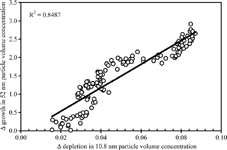
The same experiment was repeated in a shorter tunnel, Lion Rock Tunnel (LRT) (1.4 km) on 27 September 2002 and the results are shown in . LRT is a north-south oriented tunnel.
Figure 7 Concentration profiles and size distribution of ultrafine particles in Lion Rock Tunnel from 13:40 to 13:42 on 27 September 2004 (number concentration and dN/dlogDp in cm− 3).

The particle concentration profiles were similar to the TCT study, however, the 50 nm particle mode did not become the dominant mode at the exit of the tunnel. Gas concentrations (not shown) were ∼ 30% higher than TCT, this is because LRT has larger traffic flow. The maximum number concentration of the 10 nm particles in LRT was ∼ 50% higher than TCT, suggesting a higher nucleation formation rate of the particles in LRT. Since LRT is shorter and full transverse ventilation is used, the maximum concentration of particles > 30 nm in LRT were only ∼ 10% higher than in TCT. Furthermore, the coagulation rate between the 10 nm and > 30 nm particles may not be high enough to lower the 10 nm particle concentration and to make the 50 nm particles dominant. However, the increase in the 50 nm particles was obvious and significant. The coagulation rates calculated for LRT exhibited similar behavior as TCT and will not be elaborated here. Additional measurements under similar conditions in the two tunnels showing similar concentration profiles are shown in , , . It should be noted that, although the general trend of mode transformation was reproducible, the particle concentrations and size distributions at a particular location in the tunnel varied in different extent between runs.
Figure 8 Concentration profiles of ultrafine particle in Tate Cairn's Tunnel from 17:21 to 17:25 on 23 September 2004 (number concentration and dN/dlogDp in cm− 3).
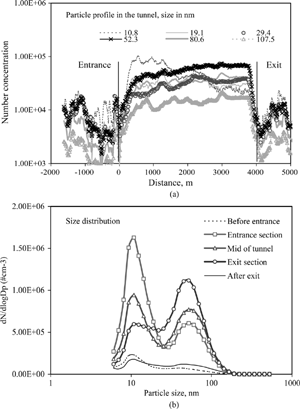
4. SUMMARY
Tunnels were used as a “controlled” environment to study the transformation of ultrafine particles emitted from road vehicles using an EEPS on a mobile platform (MAP). A bi-modal distribution pattern with a dominant mode at 10 ± 1 nm and a minor mode at 50 ± 5 nm at the entrance section of the tunnel was observed to transform as MAP traveled into the tunnel. In the initial section of the tunnel, due to the existence of precursor gases of nucleated particles in high concentrations, the formation of 10 nm particle mode by nucleation and coagulation dominated. As > 30 nm particle concentrations increased deeper in the tunnels, the coagulation between 10 nm and > 30 nm particles and between < 10 nm and > 30 nm particles accelerated and the net formation rate of 10 nm particles decreased. This caused a decrease in the 10 nm concentration with length into tunnels. The two modes sometimes switched positions at the exit section and there were drastic changes in the number concentrations of these particles. This study demonstrated that mobile time/space data are very useful in studying the interaction of background particles with freshly formed particles in vehicular plumes in tunnels. Background particles exert a significant influence on the transformation of ultrafine particles. Finally, highly nonlinear concentration profiles of the < 30 nm particles suggest that conventional point measurements may not be representative of the properties of these particles in tunnels.
Acknowledgments
This project is sponsored by the Hong Kong Jockey Club Charities Fund for which the team is grateful. TSI, Inc., USA generously loaned the EEPS (Model 3090) to the team without which this study would not be possible.
Notes
*Light traffic country road with diesel vehicles;
**High-concentration plumes in urban areas;
***High-concentration diesel plumes at traffic exchange;
REFERENCES
- Brown , D. M. , Stone , V. , Findlay , P. , Macnee , W. and Donaldson , K. 2000 . Increased Inflammation and Intracellular Calcium Caused by Ultrafine Carbon Black is Independent of Transition Metals or Other Soluble Compounds . Occup. Environ. Med. , 57 : 685 – 691 . [PUBMED] [INFOTRIEVE] [CSA]
- Bukowiecki , N. , Kittelson , D. B. , Watts , W. F. , Burtsher , H. , Weingartner , E. and Baltensperger , U. 2002 . Real-Time Characterization of Ultrafine and Accumulation Mode Particles in Ambient Combustion Aerosols . J. Aerosol Sci. , 33 : 1139 – 1154 . [CSA] [CROSSREF]
- Chang , T. Y. and Rudy , S. J. 1990 . Roadway Tunnel Air Quality Models . Environ. Sci. Technol. , 24 : 672 – 676 . [CSA] [CROSSREF]
- Churg , A. , Gilks , B. and Dai , J. 1999 . Induction of Fibrogenic Mediators by Fine and Ultrafine Titanium Dioxide in Rat Tracheal Explants . Am. J. Physiol. Lung Cell Mol. Physiol. , 277 : 21 – 25 . [CSA]
- Fuchs , N. A. 1989 . The Mechanics of Aerosols. , p. 184 New York : Dover Publications, Inc. .
- Gidhagen , L. , Johansson , C. , StrÖm , J. , Kristensson , A. , Swietlicki , E. , Pirjola , L. and Hansson , H. C. 2003 . Model Simulation of Ultrafine Particles Inside a Road Tunnel . Atmos. Environ. , 37 : 2023 – 2036 . [CSA] [CROSSREF]
- Jacobson , M. K. and Seinfeld , J. H. 2004 . Evolution of Nanoparticle Size and Mixing State Near the Point of Emission . Atmos. Environ. , 38 : 1839 – 1850 . [CSA] [CROSSREF]
- Ketzel , M. , Wåhlin , P. , Berkowicz , R. and Palmgren , F. 2003 . Particle and Trace Gas Emission Factors Under Urban Driving Conditions in Copenhagen Based on Street and Roof-Level Observations . Atmos. Environ. , 37 : 2735 – 2749 . [CSA] [CROSSREF]
- Kim , D. , Gautam , M. and Gera , D. 2002 . Parametric Studies on the Formation of Diesel Particulate Matter Via Nucleation and Coagulation Modes . J. Aerosol Sci. , 33 : 1609 – 1621 . [CSA] [CROSSREF]
- Kittelson , D. B. , Watts , W. F. and Johnson , J. P. 2004 . Nanoparticle Emissions on Minnesota Highways . Atmos. Environ. , 38 : 9 – 19 . [CSA] [CROSSREF]
- Kulmala , M. , Vehkamäki , H. , Petäjä , T. , Maso , M. D. , Lauri , A. , Kerminen , V.-M. , Birmili , W. and McMurry , P. H. 2004 . Formation and Growth Rates of Ultrafine Atmospheric Particles: A Review of Observations . Aerosol Sci. , 35 : 143 – 176 . [CSA] [CROSSREF]
- Laakso , L. , Hussein , T. , Aarnio , P. , Komppula , M. , Hiltunen , V. , Viisanen , Y. and Kulmala , M. 2003 . Diurnal and Annual Characteristics of Particles Mass and Number Concentrations in Urban, Rural and Artic Environments in Finland . Atmos. Environ. , 37 : 2629 – 2641 . [CSA] [CROSSREF]
- Lehmann , U. , Mohr , M. , Schweizer , T. and Rütter , J. 2003 . Number Size Distribution of Particulate Emissions of Heavy-Duty Engines in Real Word Test Cycles . Atmos. Environ. , 37 : 5247 – 5259 . [CSA] [CROSSREF]
- Maricq , M. M. , Chase , R. E. and Xu , N. 2001 . A Comparison of Tailpipe, Dilution Tunnel and Wind Tunnel Data in Measuring Motor Vehicle PM . J. Air & Waste Manage. Assoc. , 51 : 1529 – 1537 . [CSA]
- Molnár , P. , Janhäll , S. and Hallquist , M. 2002 . Roadside Measurements of Fine and Ultratfine Particles at a Major Road North of Gothenburg . Atmos. Environ. , 36 : 4115 – 4123 . [CSA] [CROSSREF]
- Morawska , L. , He , C. , Hitchins , J. , Mengersen , K. and Gilbert , D. 2003 . Characteristics of Particle Number and Mass Concentrations in Residential Houses in Brisbane, Australia . Atmos. Environ. , 37 : 4195 – 4203 . [CSA] [CROSSREF]
- Pakkanen , T. A. , Kerminen , V.-M. , Korhonen , C. H. , Hillamo , R. E. , Aarnio , P. , Koskentalo , T. and Maenhaut , W. 2001 . Urban and Rural Ultrafine (PM0.1) Particles in the Helsinki Area. 2001 . Atmos. Environ. , 35 : 4593 – 4607 . [CSA] [CROSSREF]
- Peters , A. , Wichmann , H. E. , Tuch , T. , Heinrich , J. and Heyder , J. 1997 . Respiratory Effects are Associated with the Number of Ultrafine Particles . Am. J. Respir. Crit. Care Med. , 155 : 1376 – 1383 . [PUBMED] [INFOTRIEVE] [CSA]
- Seinfeld , J. H. and Pandis , S. N. 1998 . Atmospheric Chemistry and Physics: From Air Pollution to Climate Change. , p. 648 – 699 . New York : John Wiley & Sons .
- Sturn , P. J. , Baltensperger , U. , Bacher , M. , Lechner , B. , Hausberger , S. , Heiden , B. , Imhof , D. , Weingartner , E. , Prevot , A. S. H. , Kurtenbach , R. and Wiesen , P. 2003 . Roadside Measurements of Particulate Matter Size Distribution . Atmos. Environ. , 37 : 5273 – 5281 . [CSA] [CROSSREF]
- Woo , K. S. , Chen , D. R. , Pui , D. Y. H. and McMurry , P. H. 2001 . Measurements of Atlanta aerosol size distributions: Observations of ultrafine particle events . Aerosol Sci. Technol. , 34 : 75 – 87 . [CSA]
- Zhang , M. K. and Wexler , A. S. 2002 . Modeling the Number Distributions of Urban and Regional Aerosols: Theoretical Foundations . Atmos. Environ. , 36 : 1863 – 1874 . [CSA] [CROSSREF]
- Zhu , Y. , Hinds , W. C. , Kim , S. , Shen , S. and Sioutas , C. 2002 . Study of Ultrafine Particles Near a Major Highway with Heavy-Duty Diesel Traffic . Atmos. Environ. , 36 : 4323 – 4335 . [CSA] [CROSSREF]

